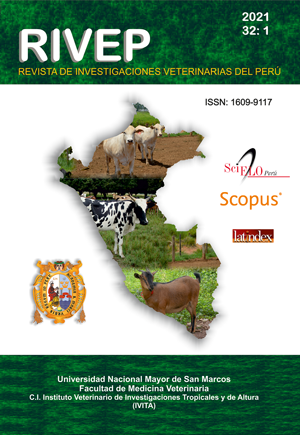Prevalence and risk factors associated with infection by Fasciola hepatica infection in cattle from peasant communities of Huancabamba (Piura-Peru)
DOI:
https://doi.org/10.15381/rivep.v32i1.19510Keywords:
Fasciola hepatica, cattle, sedimentation, risk factor, zoonosisAbstract
This study aimed to determine the prevalence and risk factors associated with bovine fasciolosis in peasant communities of the Huancabamba province (Piura, Peru). In total, 360 samples of bovine faeces were collected in the districts of Huancabamba, Sondor, Sondorillo and Carmen de la Frontera. The stool samples were analysed using the Dennis sedimentation technique. Association of the presence of Fasciola hepatica eggs in the stool with the, sex and district of origin of the animals was evaluated. The results showed that 42.5% (95% CI: 37.3-47.8%) of animals were infected with F. hepatica. The highest probability of contracting fasciolosis in cattle was in the age group of 13-18 months (PR: 2.56; 95% CI: 1.51-4.28) and from the Sondorillo district (PR: 1.41; 95% CI: 1.04-1.94); Furthermore, being male was considered a protection factor (PR: 0.69; 95% CI: 0.53-0.90). The study showed a high prevalence of bovine fasciolosis in peasant communities of Huancabamba and its association with sex, age and place of origin.
Downloads
Downloads
Published
Issue
Section
License
Copyright (c) 2021 Giovana Nancy Livia-Córdova, Cesar Abel Burga-Cisterna, Anthoni Quiroz-Dávila, Brigitte Rentería-Samamé, Andy Mercado-Gamarra, María Del Solar-Vela, Jorge Cárdenas-Callirgos

This work is licensed under a Creative Commons Attribution-NonCommercial-ShareAlike 4.0 International License.
AUTHORS RETAIN THEIR RIGHTS:
a. Authors retain their trade mark rights and patent, and also on any process or procedure described in the article.
b. Authors retain their right to share, copy, distribute, perform and publicly communicate their article (eg, to place their article in an institutional repository or publish it in a book), with an acknowledgment of its initial publication in the Revista de Investigaciones Veterinarias del Perú (RIVEP).
c. Authors retain theirs right to make a subsequent publication of their work, to use the article or any part thereof (eg a compilation of his papers, lecture notes, thesis, or a book), always indicating the source of publication (the originator of the work, journal, volume, number and date).



